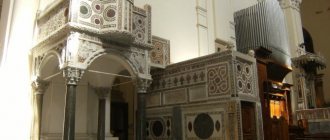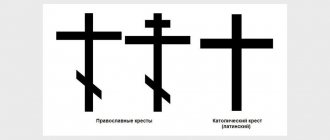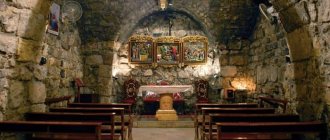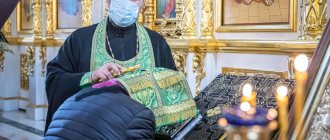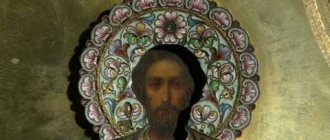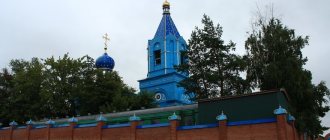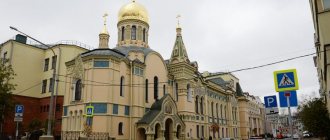LiveInternetLiveInternet
TEMPLES IN Rus' The temple is the center of church life and Orthodox culture. It was in the temple that the ambassadors of Grand Duke Vladimir were convinced of the beauty of Orthodoxy. The church service became for them a true testimony of the truth of the Orthodox faith. In 989, the year after the Baptism of Rus, the first stone church was founded in Kyiv by Greek architects who came from Constantinople (there was a wooden church in Kyiv before that). As the chronicle narrates, Prince Vladimir “thought to create the Church of the Most Holy Theotokos and, having sent, brought craftsmen from the Greeks.”
In 996, the construction was completed and the temple was solemnly consecrated. Assumption Cathedral of the Moscow Kremlin. 1475–1479 Architect Aristotle Fioravanti Donating to the temple has always been a good Orthodox tradition. In Old Testament times, everyone was ordered to give a tenth of their income to the needs of the Jerusalem Temple. Due to the special significance of the new church, Prince Vladimir also donates “tithes” to the temple he built, and from then on the church is included in people’s memory and chronicles as the Church of the Tithes. The Church of the Assumption of the Blessed Virgin Mary (Tithe) was destroyed during the capture of Kyiv by the Mongol-Tatars and stood in ruins until the 19th century.
The Tithe Church determined the appearance of Russian temple architecture for many decades. According to archaeological excavations, it was according to its model that the main churches of cities and monasteries in Rus' were built. Since the Baptism of Rus', church building on our land has acquired paramount importance.
On the site of the future settlement or city, a church is first built. All or almost all residents of a village or city come to church for services on Sundays and on great church holidays. In the church, as a rule, the baptism of newborns takes place, the wedding of newlyweds takes place here, and the funeral service for deceased Orthodox Christians is performed in the church. The church also hosts farewells to the defenders of the Fatherland during the war and thanksgiving services after the victory. Our ancestors gathered for public meetings near the temple, and a trading area was set up not far from the temple. Thus, for many centuries of Russian history, the Orthodox church has been both a place of general public meetings and a place of sanctification of all aspects of human life. Since the temple in Rus' occupied an extremely important place in the life of an Orthodox person, all the best was given to the creation and decoration of churches: the best forces, the best talents and the greatest funds were donated.
The temple was usually built on an elevated, “red” place (i.e. the best, most beautiful) and served as the basis for the entire urban planning plan. If residents of a city or village had to change their place of residence, then their first concern was the construction of a temple, and preferably one like the one they had at their previous place of residence. Temples in Rus' were dedicated to the Life-Giving Trinity, Christ the Savior, the Mother of God or saints. Russian cities, villages, streets, and roads were often named after the temple. The surnames of many people also came from the names of churches, especially the surnames of people from the clergy class: Voznesensky, Pokrovsky, Uspensky...
Throughout Christian times, monumental churches were erected in Rus'. They were built on the site of great battles and military victories for the sake of constant church commemoration of those who laid down their lives on the battlefield for their hometown, people and their Fatherland. Thanks to temples and temple construction, Russian architecture and all types of church art related to worship, usually performed in a temple, developed over more than ten centuries. The best Russian churches have become the glory of Russia. The Kiev and Novgorod St. Sophia Cathedrals, the Assumption Cathedral in Vladimir, the Assumption Cathedral of the Moscow Kremlin, the Trinity Cathedral of the Trinity-Sergius Lavra, St. Isaac's Cathedral in St. Petersburg, the Vladimir Cathedral in Kiev and many other churches in Russia are recognized as monuments of world culture. The temple in Rus' has always served as the most striking evidence of the conciliarity of Orthodox culture. He literally gathered citizens and, thanks to a single church calendar, streamlined all church and social life. In churches, royal decrees were announced, metropolitans were elected, and kings were anointed to the throne. Church councils were held in churches, the decisions of which largely determined the development of national history and culture. Finally, the temple in Rus' was also the first school for many centuries.
There were always books here, since church services cannot be performed without books. There were always literate people at the temple who taught literacy and various church arts to adults and children. Scriptoriums (workshops for copying books), archives and libraries were established at churches and monasteries, schools were founded, and, from the 19th century, parochial schools. Church chants helped to assimilate and remember a lot from books: books were read loudly, prayers were sung, many elements of the service were often repeated and, thanks to this, the most important provisions of faith and life were assimilated. Church of All Saints who shone forth in the Russian Land. 1991 Novosibirsk Academic Town Temples in Rus' have always been a treasury of shrines for the people. Ancient Rus' did not know museums: everything truly valuable and beautiful was kept in churches or monasteries - revered icons, remains of saints (relics), ancient manuscripts, sometimes ancient documents and various relics.
Thus, the temple in Rus' is the main custodian of Orthodox culture. Temples in Rus' at all times reflected the spiritual and moral state of society. During wars and social unrest, churches were often destroyed. During periods of spiritual uplift and national revival, churches were also revived. For an Orthodox person, a temple is always a special, holy place. “In the temple worth Your glory, we stand in heaven,” says one church prayer (i.e., being in the temple, we are as if in heaven). Indeed, the domes of Orthodox churches always point towards the sky. All this testifies to the enduring significance of the temple in the Orthodox culture of Russia. https://pkr.orthgymn.ru/textbook/p13.html
Who should we go to?
When can we say that a person has become a church member? It seems to me that only starting from the moment when he feels himself already belonging to the Church. Belonging to her in the deepest sense of the word, when he feels that he has become part of her and can no longer imagine his life outside of her. It may not be easy for him in the Church, he may not like everything about its human, let’s say, element, but he can no longer live without it. You probably remember such a moment in the Gospel of John, when the Lord spoke to the Jews about the Bread coming from Heaven, that is, about Himself, and spoke for the first time about the future Sacrament of the Eucharist. And to the Jews this teaching seemed so incredible, incomprehensible to their limited human mind, that they began to move away from Christ. Even some of the disciples walked away, saying: “What strange words! Who can listen to this? (John 6:60 ). And then the Lord asked His closest disciples from among the twelve, His apostles, if they also wanted to leave Him. Peter answered Him on behalf of everyone. He said: “Lord! who should we go to? You have the words of eternal life” (John 6:68 ).
And when a person has such an attitude towards the Church in his soul, then we can say that he really belongs to it, has become its property.
However, at the same time, the Church becomes “his own” for him; he begins to perceive it not just as a place where he comes to pray, but as something that belongs to him. Not alone, of course, but together with all those people who make it up here on earth. That is, there is a feeling of community, a feeling that there is a single whole, of which you are an integral, natural part.
But, of course, we can talk about different degrees of church involvement, about different depths of a person’s church consciousness.
It's hard to figure out, but you can read it
But worship is not only a certain sequence of chants, prayers, and actions of the priest and deacon. This is also a very deep symbolism, originally inherent in it. What, for example, does incense mean, except that at the moment of its commission the temple is filled with the fragrance of incense? This is an image of the Holy Spirit acting in the Church, and at the same time - an image of prayer, ascending, as it is said in the Apocalypse, to heaven, like incense [].
Or what does such an unimportant detail on a priest’s vestment mean, like the fringe at the bottom, why can’t it be sewn without it? This is angel plumage. And the deacon’s orarion - at some moments it becomes a wing with which he, like the six-winged seraphim, closes his eyes, which cannot look at the Divine glory.
You can hardly think of all this on your own. But you can also read about this in books on liturgics, the science of worship. Of the simplest and, if I may say so, basic, there are probably two that need to be named. This is the “New Tablet” of Bishop Venimin of Nizhny Novgorod and Arzamas and the works of St. Simeon of Thessalonica. Understanding the symbolic side of worship will make our perception of it more complete and profound.
Unfamiliar familiar language
What does it take to learn to understand worship?
First of all, as we said, attention, interest, attitude towards it as the most important thing that happens in the temple. By the way, when a person really listens to the singing and reading, he begins to understand how untrue the statement is that the Church Slavonic language is incomprehensible to the majority of those who come to the Church. On the contrary, because most of the words in it are familiar to each of us. And many unfamiliar words become understandable due to the fact that we think logically, and logic itself tells us their meaning.
Although, of course, there are words that cannot be understood right away. But this should only give the recognition process additional urgency and interest. And you just need to pick up a Church Slavonic dictionary to make amazing discoveries, learning, for example, that the word “justification”—remember, we ask the Lord to teach us “His justifications”—really means “commands.” And the word “mocked” means “thought.” And the “brazen death” from which we ask to be delivered is a quick, unexpected, unexpected death.
Today, many such dictionaries have already been published, there is the “Complete Church Slavonic Dictionary” by Archpriest Grigory Dyachenko, there is the wonderful “Teaching Psalter” with translation from Church Slavonic into Russian and a number of other publications. Moreover, you can find them not only in stores and libraries, but even on the Internet.
There is no monotony in prayer
But we will still stand before the meaning of other words or prayers, as if in front of a wall, until our own life helps us understand them - real, external life. And at the same time, internal life, including prayer. In general, home and private prayer is one of the best means of understanding church services. And not only because in it a person has more control over himself and his time and can figure out what is not yet clear to him. In home prayer, we have time and freedom for something else: in order to dwell on what touched our heart, aroused its sympathy, we have the opportunity to pray more focused, consciously, even creatively. And this experience of prayer, which we gradually acquire, helps later in church. And to a person who is not just present at the service, but prays at it, it no longer seems monotonous, because his heart will respond differently to the same words each time.
Church songwriters
It is also interesting to learn about the people who wrote the liturgical texts - after all, it is interesting for us to know who owned the painting we liked or the music that struck a chord. This is all the more interesting in this case, because there are fewer great hymnographers than great writers, musicians and painters.
Every service necessarily contains psalms, both in full and in individual verses. And, of course, it is difficult to understand them without knowing anything about their author, the king and prophet David, about his battle against Goliath, about his persecution by Saul, about his misunderstanding of his wife, about his fall, when, having submitted to blind passion, he not only commits adultery , but also sends the husband of his beloved to certain death.
There is the Great Penitential Canon, perhaps the most amazing, truly great creation of church hymnography. And it is impossible not to know anything about its creator, St. Andrew, Bishop of Crete.
But how can you truly, fully understand the wonderful stichera that is sung on Wednesday of Holy Week: “Lord, even the woman who has fallen into many sins...” if you know nothing about its author? It talks about a harlot woman who anointed the Savior’s feet with myrrh. But it was written by a nun, nun Cassia, a failed Byzantine empress, the bride of Emperor Theophilus rejected for her wisdom. And what kind of life and spiritual experience she used as the basis for this deepest chant - it’s worth thinking about.
And there is much more that is also necessary and important to know. And here books also come to the rescue. For example, “Gymnography and Eortology” [] by Archimandrite Cyprian Kern. The title seems complicated, but the book is small and easy to read. Or another work, even closer to us in time, left by the recently deceased schema-nun Ignatius: “Church Song Makers” [].
